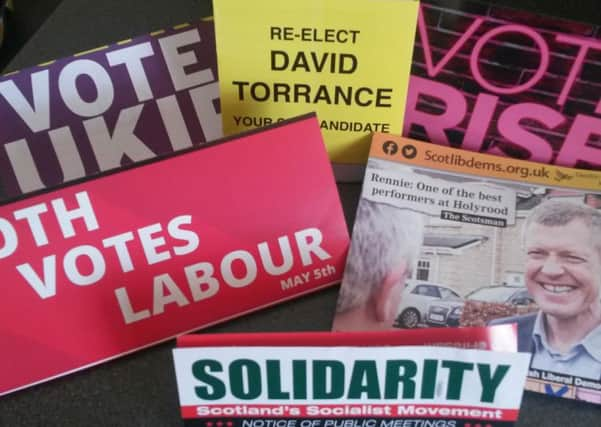Election 2016: The '˜Kirkcaldy factor' ...


The Lang Toun is often seen a barometer for the rest of the country - so whichever party triumphs here can, so the theory goes, look ahead to a good night as the results roll in.
Kirkcaldy, like many towns in Fife, was a Labour stronghold, but the landscape changed in 2011. Then came the indyref and a General election and, somewhere in there, the party’s huge bloc vote simply withered.
Advertisement
Hide AdAdvertisement
Hide AdThe town has since elected an SNP MP and MSP, but Labour want the Holyrood seat back - it’s number two on the party’s list of targets.
To do that it’ll have to depose David Torrance, the man whose triumph in 2011 gave the SNP its historic majority at Holyrood.
Regarded as a hardworking politician within his constituency, his result was huge in terms of the national picture, but his own margin of victory was actually narrow - six years ago, there were just 200 votes between him and Labour’s long-serving MSP, Marilyn Livingstone.
Now, Labour have pitched Claire Baker, one of their Shadow Cabinet, against him.
Advertisement
Hide AdAdvertisement
Hide AdShe has represented the town on the Mid-Scotland and Fife list since 2007 - a position she ought to retain as she is number two behind Alex Rowley on the party’s Mid-Scotland list - but is now bidding to win in the first past the post vote.
With an office in the town and a high profile locally, Ms Baker is confident of success. Her own verdict from the doorsteps is people are listening again to a party that had such huge support they did indeed weigh rather than count the votes.
And the numbers are interesting.
In all the Scottish parliamentary elections since 1999 Labour’s vote share in Kirkcaldy has actually held up.
Mrs Livingstone had 48 per cent of the vote when elected in 1999 and 44.6 per cent when she exited politics in 2011.
Advertisement
Hide AdAdvertisement
Hide AdBut the SNP has made solid ground over that time - Stewart Hosie’s 32% in 1999, dipped in 2003, and then rose to 33 per cent when Chris Harvie stood in 2007 before Mr Torrance swept home with 45.2 per cent in 2011.
But those numbers don’t reflect the bigger picture and the radical transformation of Scotland’s political landscape from red to yellow.
These days in Kirkcaldy you are more likely to see SNP posters in windows than the traditional Labour ones - the giant ‘Vote David Torrance’ banner strung across the balcony of the high rise flats on the Esplanade, for example, underlines how much has changed, as does one anecdote.
Mr Torrance tells the story of how he used to knock on the same Templehall door at every single election knowing the residents were solid Labour. Last time round they stopped him in his tracks when they asked for a leaflet and said they were backing the SNP. He knew then things were very different. Voting patterns built up over generations had changed, possibly forever.
Advertisement
Hide AdAdvertisement
Hide AdSix years and one independence referendum on, and all eyes are now on how those core Labour folk will vote.
The party was in power in Kirkcaldy for decades - both locally and at Westminster - and with local authority elections due in 2017, it will be keen to see success at the count this evening to give it a platform to build on.
The Lib Dems and Tories are also both contesting Kirkcaldy, but, in reality, this a two-horse race.
The Tory vote locally has dropped to around 2000 - candidate Martin Laidlaw is aiming to get that up to 3000 but to do that he will have to turn back the clock to 1999 when Mike-Scott Hayward stood.
Advertisement
Hide AdAdvertisement
Hide AdThe Lib Dems’ traditional pockets of support have withered in recent elections - a direct result of their time in coalition with the Conservatives at Westminster. Last time round they barely scraped 800 votes, and that trend has continued at local by-elections with some dreadful figures. Candidate Lauren Jones faces a big challenge reversing that trend.
The party’s prospects in north-east Fife are very different. The seat is in their top three electoral targets, and they’ve put party leader, Willie Rennie, up against the incumbent Rod Campbell (SNP).
The unknown factor remains how the Tories will fare in the more rural setting where they’ve finished as high as second place in three previous elections. There’s a lot riding on the shoulders of candidate, Huw Bell.
One outcome is guaranteed - Glenrothes and Leven will get a new MSP following the retiral of Tricia Marwick.
Advertisement
Hide AdAdvertisement
Hide AdHer Mid-Fife and Glenrothes seat - the old Central Fife constituency once represented by Henry McLeish and then Christine May - is up for grabs.
All the main parties are fielding candidates but in reality it’s a bunfight between Labour’s Kay Morrison and the SNP’s Jenny Gilruth.
The latter has been bequeathed a solid 4000 majority by Mrs Marwick, but she is up against a long-serving councillor.
Results aren’t expected until the early hours of Friday morning, 2.00 a.m. or later - the Fife count has a reputation for taking its time! - but whenever and however the chips fall, it is going to be a long and fascinating night ...